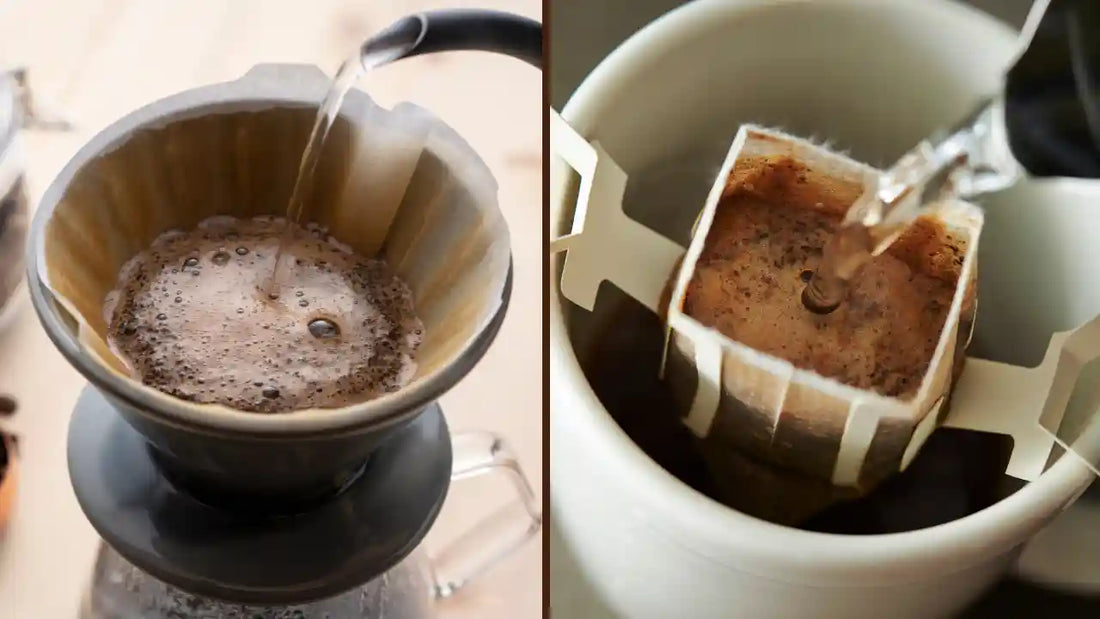
Pour over vs. Drip coffee: Key Differences Explained
Share
At first glance, pour over and drip coffee might seem nearly identical. Both use a paper filter, ground coffee, and hot water. Both produce a clean, smooth cup. So… what’s the real difference?
The answer lies in how the water interacts with the coffee, and how much control you have over that process. One method lets you finesse every detail; the other handles it for you.
Depending on your preferences, one may suit your lifestyle, taste, and routine far better than the other.
In this blog, we’ll break down:
- What pour over and drip coffee actually are
- How they differ in technique, taste, gear, and effort
- Which method might be right for you and why it matters
Let’s dive in and help you brew better coffee, your way.
What is Pour Over Coffee?
Pour over is a manual brewing method where hot water is poured slowly and evenly over coffee grounds in a filter, typically using a cone-shaped dripper like a V60, Kalita Wave, or Chemex.
The process is done entirely by hand, which gives the brewer full control over:
- Water flow
- Pouring speed and pattern
- Brew time
- Saturation and agitation
This level of control allows you to highlight delicate flavors and adjust the brew to your personal taste.
Pour over is especially loved in the specialty coffee world because it:
- Produces a clean, crisp, and complex cup
- Brings out bright acidity and floral/fruity notes
- Works best with single origin beans that have nuanced flavors
- Feels more like a ritual, meditative, slow, and precise
That said, it takes a little more time and attention than other methods. But for many, that’s part of the appeal.
What is Drip Coffee?
Drip coffee refers to coffee brewed using an automatic drip machine, the kind commonly found in homes, offices, and diners. You add ground coffee to a paper filter, fill the water tank, press a button, and the machine does the rest.
Here’s how it works:
- Water is heated inside the machine and then dripped evenly over the coffee grounds
- Gravity pulls the brewed coffee through the filter and into a carafe or cup
- The process is fully automated — no need to control pour rate, timing, or technique
Drip coffee machines are loved for their:
- Convenience and consistency
- Ability to brew multiple cups at once
- Low learning curve - just grind, fill, and press a button
Flavor-wise, drip coffee tends to be more rounded and mellow, with slightly less clarity than a well-executed pour over.
But it’s a reliable choice for anyone who wants good coffee with minimal effort. Want to know more about Drip technique? In depth maybe? Please refer to the Drip Coffee: A Timeless Brewing Method blog then.
Key Differences Between Pour Over Coffee and Drip Coffee
While both methods use similar ingredients: water, coffee, and a filter. The way they’re brewed leads to noticeable differences in flavor, control, and overall experience.
Here’s how they compare:
1. Control Over Brewing Variables
- Pour Over gives you full control over pour rate, water distribution, brew time, and agitation. You shape the cup.
- Drip Coffee automates the process. You have limited control over water flow or brew time.
✅ If you enjoy experimenting and fine-tuning your brew, pour over is the clear winner.
2. Flavor Profile
- Pour Over often produces a brighter, more delicate, and layered cup. It highlights origin flavors like floral, fruity, or citrus notes.
- Drip Coffee leans toward a more rounded, muted profile. Great for everyday drinking but with less complexity.
✅ For single origin beans and nuance, pour over excels. For comfort and consistency, drip works well.
3. Skill & Learning Curve
-
Pour Over requires technique, learning to pour evenly, get the right grind size, and time your brew.
-
Drip Coffee is plug-and-play. Fill it, forget it.
✅ Beginners may prefer drip at first, while coffee enthusiasts may enjoy the pour over learning journey.
4. Time & Effort
- Pour Over takes 3–5 minutes and your attention throughout.
- Drip Coffee takes similar brew time but requires no active involvement.
✅ For busy mornings, drip is convenient. For slow weekend brewing, pour over can be rewarding.
5. Equipment & Setup
- Pour Over needs a dripper, filters, kettle (ideally gooseneck), and scale.
- Drip Coffee just needs a machine.
✅ Pour over setup is compact and travel-friendly. Drip machines brew more at once but take more space.
6. Quantity Brewed
- Pour Over is best for 1–2 cups at a time.
- Drip Coffee can brew a whole pot (up to 12 cups).
✅ For groups or offices, drip coffee is more practical.
Which one amongst the Pour Over and Drip Coffee Technique Makes Better Coffee?
Let’s be honest: “better” depends on what you’re looking for.
If you value flavor clarity, control, and craft, pour over typically wins.
It brings out nuanced notes in single origin beans: citrus, florals, berries, and delicate sweetness, especially when brewed with precision. If you enjoy the ritual and don’t mind the hands-on approach, pour over can deliver an exceptional cup.
If you value convenience, consistency, and volume, drip coffee might suit you better.
It gives you decent coffee with minimal effort, especially if you’re brewing for more than one person.
Modern drip machines have also improved in quality, with some offering features like bloom stages and temperature control.
So which one’s better?
- If coffee is a ritual or hobby, go for pour over.
- If coffee is a routine or necessity, drip might be your best friend.
No method is universally better, it all comes down to your taste, time, and lifestyle.
Comparison Chart: Pour Over vs. Drip Coffee
|
Feature |
Pour Over |
Drip Coffee |
|---|---|---|
|
Brew Control |
High — manual control over every variable |
Low — machine-controlled |
|
Flavor Profile |
Bright, complex, nuanced |
Smooth, rounded, consistent |
|
Ease of Use |
Requires practice and focus |
Very easy and beginner-friendly |
|
Gear Needed |
Dripper, filter, gooseneck kettle, scale |
Coffee machine, filter |
|
Brew Time |
~3–5 minutes (hands-on) |
~3–5 minutes (hands-off) |
|
Batch Size |
1–2 cups optimal |
Ideal for multiple cups (4–12) |
|
Best For |
Coffee hobbyists, flavor explorers |
Busy drinkers, families, offices |
|
Learning Curve |
Moderate to high |
Low |
Who Should Choose Pour Over?
Pour over is for those who see coffee as more than a caffeine fix. If any of these sound like you, this method might just be your perfect match:
1. You enjoy the ritual.
There’s something calming about heating the water, placing the filter, and pouring slowly in concentric circles. For many, it’s a mindful start to the day.
2. You want to taste the fine details.
Pour over brings out clarity and brightness in a coffee’s flavor, perfect for exploring single origin beans with unique tasting notes.
3. You like experimenting.
Want to try a coarser grind? Or a longer pour? Or adjust your water temperature? Pour over gives you that freedom, and rewards curiosity.
4. You usually brew 1–2 cups at a time.
Pour over shines when brewing small batches. It’s not built for volume, it’s built for quality.
If you care about control, nuance, and process, pour over is likely the method you’ll fall in love with.
BrewClan Tip: Great Beans Make Both Methods Shine
Here’s the truth: whether you use a manual pour over or a drip machine, the biggest difference-maker is the coffee itself.
Even the most advanced brewer can’t rescue dull, stale beans. And even the simplest machine can produce a great cup if the beans are fresh, well-roasted, and thoughtfully sourced.
That’s where we come in.
At BrewClan, we roast specialty-grade coffee in small batches, ship it fresh, and offer a variety of roast profiles and grinds, perfect for both pour over and drip.
Whether you’re a hands-on coffee geek or a convenience-first drinker, we’ve got beans that suit your taste and brew method.
Try us once, we won’t have to convince you again.
→ Explore Fresh Roasted Coffee
To Conclude
Pour over and drip coffee may seem similar, but the difference lies in the process, control, and personality behind each brew.
- Pour over is hands-on, precise, and perfect for exploring complex flavors.
- Drip coffee is convenient, consistent, and great for larger batches or busy mornings.
There’s no winner, just the method that fits your style best.
But no matter how you brew, one thing stays true: fresh, well-roasted beans make all the difference.
FAQs - Frequently Asked Questions
1. Is pour over coffee better than drip?
Pour over gives you more control over brewing, which often results in a cleaner, brighter cup. But drip coffee is more convenient and consistent for larger batches. “Better” depends on your preference.
2. Does pour over coffee taste different from drip?
Yes. Pour over coffee typically has a cleaner, more nuanced flavor, while drip coffee tends to be more mellow and rounded due to automated water flow.
3. Which is faster: pour over or drip?
Both take around 3–5 minutes to brew, but pour over requires active attention, while drip coffee is hands-off once started.
4. Can I use the same coffee beans for both methods?
Absolutely. The same beans can work well in both methods, but using freshly roasted specialty beans (like BrewClan’s) enhances the flavor in either.
5. Which method is better for beginners?
Drip coffee is easier for beginners due to its simplicity. Pour over has a steeper learning curve but offers more control and flavor rewards.
6. Is pour over stronger than drip coffee?
Not necessarily. Strength depends on brew ratio and grind size, not the method itself. You can make strong or mild coffee with either.




